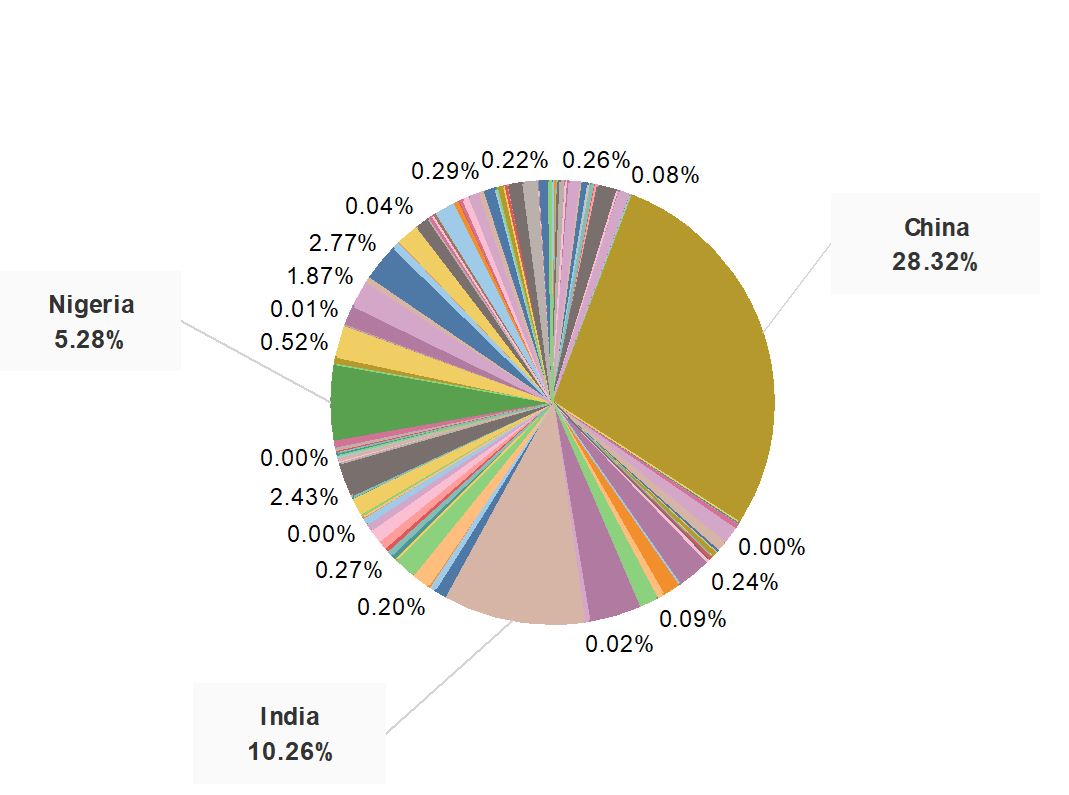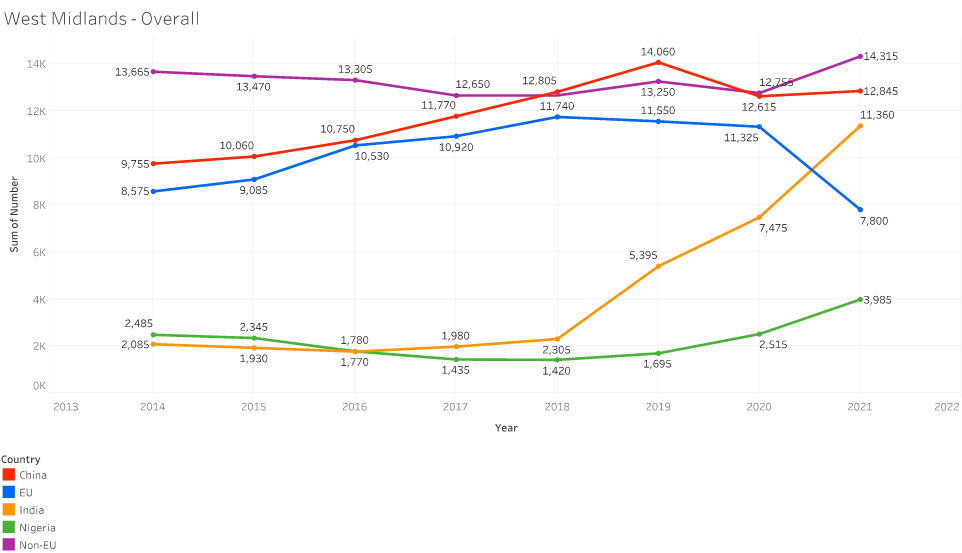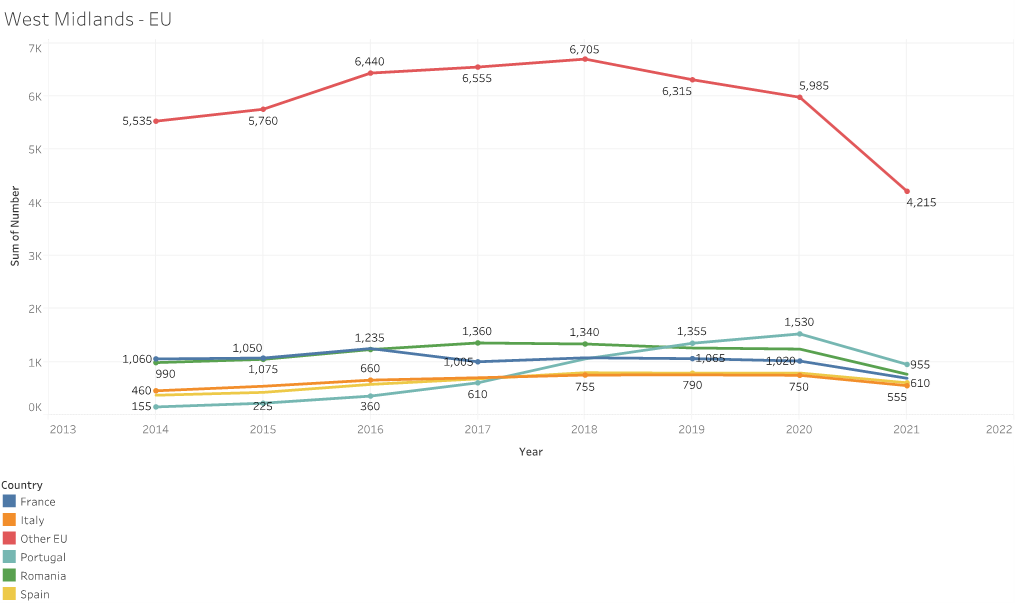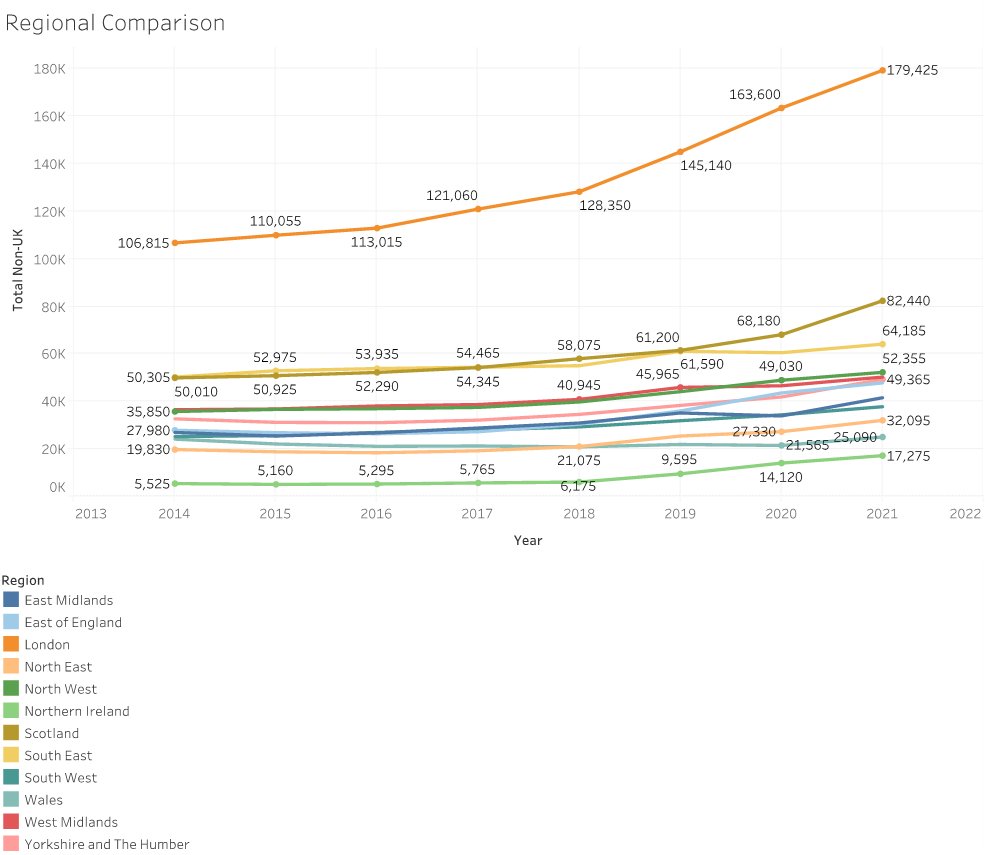
Summer intern Dimas Almaruf presents the first part of a two-part series of blogs on the economic impact of international students in the UK. Part I sets the scene by providing the number of students in the region.
Introduction
The United Kingdom has long been a favourite destination for international students to pursue their higher education at all levels. This article discusses the insights into the presence of international students in the UK, their contributions, and the challenges they face during their study time.
The numbers at a glance
The UK has been a magnet for international students, and the numbers continue to rise. According to the Higher Education Statistics Agency (HESA), in the academic year 2021/2022, the UK hosted a staggering 679,970 international students, comprising 120,140 EU-domiciled students and 559,825 from various countries worldwide. The number has increased from 442,225 in 2014 (53%) when the data was first recorded by HESA. This number signifies the UK’s continued appeal as a global educational hub. In addition to that, this article focuses on observing the number of international students in the West Midlands, in which the region hosted more than 50,000 students at its 15 higher education providers.
Figure 1 – Percentage of student’s domicile in the West Midlands in the 2021/2022 academic year

Figure 1 shows China, India, and Nigeria stand out as the top three exporters of international students to the West Midlands.
In the 2021/2022 academic year, China comprises 28% or 12,845 of the total international student population in the West Midlands. Meanwhile, India is in the second position with 10% or 11,360 students coming to the UK to study. The number of Nigerian students studying in British universities in the West Midlands is 3,985 students, comprising 5% of the total international student population in the area. Figure 2 shows the change in international students in the West Midlands between 2014 and 2021. The figure shows that overall the international student population has grown from 36,000 to over 50,000. The make-up has also changed. India is on the rise, while Figure 3 depicts a drop off in EU students post Brexit in 2020, although EU students are a small fraction of total international students.
Figure 2 – The number of international students in the West Midlands from 2014 to 2021 academic year

Figure 3 – EU students coming to the UK from 2014 to 2021 academic year

While the UK attracts students from all over the world, the distribution of international students across regions varies significantly (see Figure 4). London attracts the highest number of students, indicating its enduring appeal as a global business & educational hub. The number of international students in the West Midlands is very similar to those studying in the North West and Yorkshire and The Humber regions. However, the North East and North West regions exhibit comparatively lower enrolment figures, reflecting potentially lesser educational infrastructure and post-graduation opportunities.
Figure 4 – International students by region from 2014 to 2021 academic year
The benefits of hosting international students
The UK derives substantial benefits from international students. According to a report by Cannings et al (2023), hosting international students for a single cohort incurs a total cost of £4.4 billion, but it generates a cumulative net benefit of £37.4 billion from various activities associated with international students and their dependents throughout their study. The economic impacts generated by international students mainly come from tuition fees, housing rent, entertainment, and daily food consumption. A more detailed discussion pertaining to the economic benefits of international students will be available in the next chapter of this series.
Diversity and productivity
Given the nature of international students, diversity is the biggest investment they have brought to the UK during their study time. Diversity is not merely just a jargon, it is a catalyst for innovation. Research by Vegt & Janssen (2003) shows that a diverse team, led by effective leadership, can significantly boost a company’s performance. Therefore, UK business organisations must anticipate this potential by opening opportunities for international students to start their careers here upon their graduation. The diversity attached to international students, combined with a high qualification from British universities, will significantly boost earning potential and thus, contribute to the regional economic growth.
The costs
Hosting international students does come at a cost, with expenses associated with their stay in the UK, including healthcare, housing, and education. Notably, the UK government (2023) introduced changes in the NHS Immigration Health Surcharge, impacting the costs associated with international students’ healthcare.
The most prominent issue with rising student numbers is the impact on the local housing market. An issue that can be viewed at the regional level.
The challenges for the region – Housing
As the number of international students in the UK continues to rise, the demand for student housing has surged, creating a housing crisis. A survey by StuRent (2022) revealed a shortfall of 207,000 beds for students nationwide. Birmingham City, a popular destination for international students, suffered a 10% undersupply of beds in the 2022/2023 academic year.
Birmingham City Council’s simulation for the 2023/2024 academic year demonstrates the extent of the issue. The potential future demand for student housing in Birmingham City is estimated to be between 46,640 and 47,640, while the existing and committed supply falls short at 29,751. This indicates a substantial shortfall in available housing for international and local students alike.
Table 1. Housing shortage projection in Birmingham City
| University/ Location | Selly Oak/ Edgbaston | City Centre | Bartley Green | City-wide |
| Potential future demand | 24,407 – 25,407 | 21,717 | 516 | 46,640 – 47,640 |
| Existing + Committed Supply | 10,357 | 19,088 | 306 | 29,751 |
| Shortfall/ surplus | -14,050 to -15,050 | -2,629 | -210 | -16,889 to -17,889 |
Source: Birmingham City Council (2023)
The housing scarcity issue affects international students disproportionately. As the UK’s population is set to expand by 27% between 2020 and 2030, the demand for university housing is expected to surge, further exacerbating the crisis (HEPI, 2020). In addition to the housing crisis, international students have faced other challenges, such as the impacts of Brexit on tuition fees and immigration status, as well as the loss of support schemes like the Erasmus+ program.
Conclusion
International students continue to play a pivotal role in the UK’s higher education landscape, both in terms of contributions and challenges. The housing crisis poses a significant obstacle for both international students and local residents affected, but it’s a reflection of the UK’s enduring appeal as a global education destination. The costs of hosting international students are outweighed by the long-term benefits, making them a valuable asset to the country’s education system and its economy. As the demand for student housing continues to grow, addressing this issue becomes crucial to maintaining the UK’s status as a top destination for international education.
This blog shares some initial findings of a new project in collaboration with the Birmingham Commonwealth Association considering the impact of international students in the West Midlands. For more information and the latest update contact Dr Matthew Lyons.
This blog was written by Dimas Almaruf, Summer Intern, City-REDI / WMREDI, University of Birmingham.
Disclaimer:
The views expressed in this analysis post are those of the authors and not necessarily those of City-REDI, WMREDI or the University of Birmingham.

